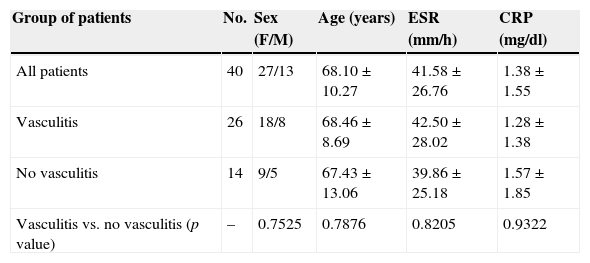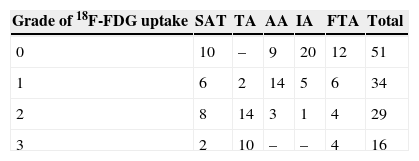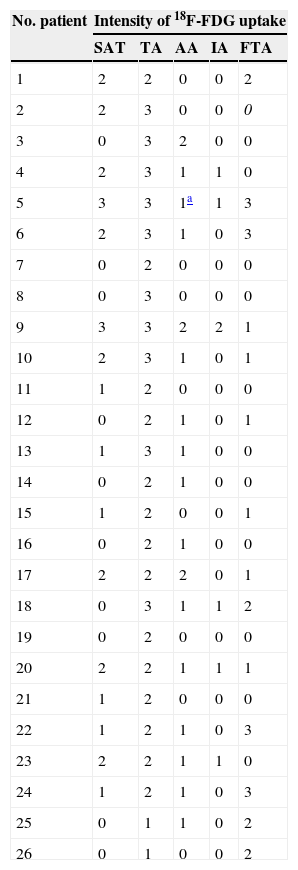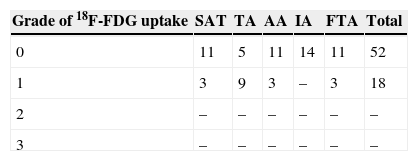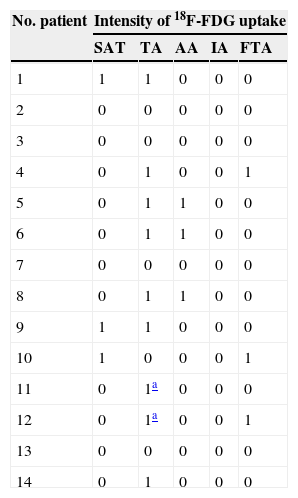Polymyalgia rheumatica (PMR) may present together with large vessel vasculitis (LVV), and frequently requires a more intensive therapy. The aim of the study was to evaluate the impact of 18F-FDG PET/CT in the diagnosis and management of LVV associated to PMR.
Material and methodsThis prospective study included 40 consecutive patients (27 women/13 men, 68.10±10.27 years) with PMR and suspicion of associated LVV submitted for 18F-FDG PET/CT. A PET/CT scan was obtained 180min after 18F-FDG intravenous injection. A visual analysis was performed on the images. Five vascular regions were evaluated: supra-aortic trunks (SAT), thoracic aorta (TA), abdominal aorta (AA), iliac arteries (IA), and femoral/tibioperoneal arteries (FTA). The intensity of uptake was graded from 0 to 3. A final diagnosis of LVV was established in 26/40 patients (65%).
ResultsIn the 26 patients with a diagnosis of LVV, the highest intensity of 18F-FDG uptake was observed in the TA, SAT, and FTA. All of these patients showed uptake at the TA, with grade 2 and 3 in most cases. In 4 of the 14 patients without LVV, no uptake was observed in any vascular region, and in the other 10 patients only a grade 1 uptake was observed in 1 or to 2 territories. Out of the 20 treated LVV patients, 18F-FDG PET/CT led to a therapeutic change in 17 (85%).
Conclusion18F-FDG PET/CT was useful in identifying patients with LVV associated to PMR. The detection of vascular inflammation had an important impact, and led to a change of treatment in a high percentage of patients with LVV.
La polimialgia reumática (PMR) puede presentarse asociada a vasculitis de grandes vasos (VGV), necesitando frecuentemente una intensificación del tratamiento. Nuestro objetivo fue evaluar el impacto de la 18F-FDG PET/TAC en el diagnóstico y tratamiento de VGV asociada a PMR.
Material y métodosEste estudio prospectivo incluyó 40 pacientes consecutivos (27 mujeres/13 hombres, 68,10±10,27 años) con PMR y sospecha de VGV asociada evaluados con 18F-FDG PET/TAC. Los estudios PET/TAC fueron obtenidos 180 minutos después de la inyección intravenosa de 18F-FDG. Se realizó un análisis visual de la intensidad de captación (0–3) en troncos supraaórticos (TSA), aorta torácica (AT), aorta abdominal (AA), arterias ilíacas (AI) y arterias femoro/tibioperoneales (AFT). Se estableció un diagnóstico final de VGV en 26/40 pacientes (65%).
ResultadosEn los 26 pacientes con diagnóstico de VGV la mayor intensidad de captación de 18F-FDG se objetivó en AT, TSA y AFT. En todos ellos se observó captación en la AT, principalmente grado 2 y 3. En 4 de los 14 sin VGV no se visualizó captación en ninguna región vascular y en los otros 10 solo se observó captación grado 1 en uno o 2 territorios. De los 20 pacientes con VGV previamente tratados, la 18F-FDG PET/TC motivó un cambio terapéutico en 17 (85%).
ConclusionesLa 18F-FDG PET/TAC fue una herramienta útil para identificar pacientes con VGV asociada a PMR. La detección de inflamación vascular tuvo un importante impacto, motivando un cambio de tratamiento en un alto porcentaje de los pacientes con VGV.
Artículo
Comprando el artículo el PDF del mismo podrá ser descargado
Precio 19,34 €
Comprar ahora









